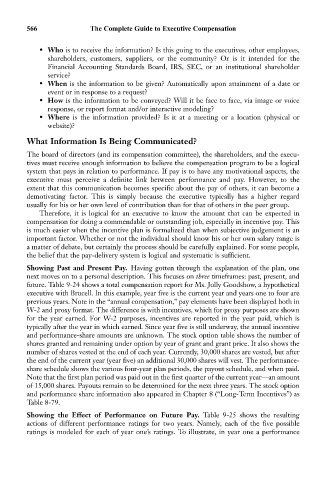Page 580 - Bruce Ellig - The Complete Guide to Executive Compensation (2007)
P. 580
566 The Complete Guide to Executive Compensation
• Who is to receive the information? Is this going to the executives, other employees,
shareholders, customers, suppliers, or the community? Or is it intended for the
Financial Accounting Standards Board, IRS, SEC, or an institutional shareholder
service?
• When is the information to be given? Automatically upon attainment of a date or
event or in response to a request?
• How is the information to be conveyed? Will it be face to face, via image or voice
response, or report format and/or interactive modeling?
• Where is the information provided? Is it at a meeting or a location (physical or
website)?
What Information Is Being Communicated?
The board of directors (and its compensation committee), the shareholders, and the execu-
tives must receive enough information to believe the compensation program to be a logical
system that pays in relation to performance. If pay is to have any motivational aspects, the
executive must perceive a definite link between performance and pay. However, to the
extent that this communication becomes specific about the pay of others, it can become a
demotivating factor. This is simply because the executive typically has a higher regard
usually for his or her own level of contribution than for that of others in the peer group.
Therefore, it is logical for an executive to know the amount that can be expected in
compensation for doing a commendable or outstanding job, especially in incentive pay. This
is much easier when the incentive plan is formalized than when subjective judgement is an
important factor. Whether or not the individual should know his or her own salary range is
a matter of debate, but certainly the process should be carefully explained. For some people,
the belief that the pay-delivery system is logical and systematic is sufficient.
Showing Past and Present Pay. Having gotten through the explanation of the plan, one
next moves on to a personal description. This focuses on three timeframes: past, present, and
future. Table 9-24 shows a total compensation report for Ms. Jolly Goodshow, a hypothetical
executive with Brucell. In this example, year five is the current year and years one to four are
previous years. Note in the “annual compensation,” pay elements have been displayed both in
W-2 and proxy format. The difference is with incentives, which for proxy purposes are shown
for the year earned. For W-2 purposes, incentives are reported in the year paid, which is
typically after the year in which earned. Since year five is still underway, the annual incentive
and performance-share amounts are unknown. The stock option table shows the number of
shares granted and remaining under option by year of grant and grant price. It also shows the
number of shares vested at the end of each year. Currently, 30,000 shares are vested, but after
the end of the current year (year five) an additional 30,000 shares will vest. The performance-
share schedule shows the various four-year plan periods, the payout schedule, and when paid.
Note that the first plan period was paid out in the first quarter of the current year—an amount
of 15,000 shares. Payouts remain to be determined for the next three years. The stock option
and performance share information also appeared in Chapter 8 (“Long-Term Incentives”) as
Table 8-79.
Showing the Effect of Performance on Future Pay. Table 9-25 shows the resulting
actions of different performance ratings for two years. Namely, each of the five possible
ratings is modeled for each of year one’s ratings. To illustrate, in year one a performance

